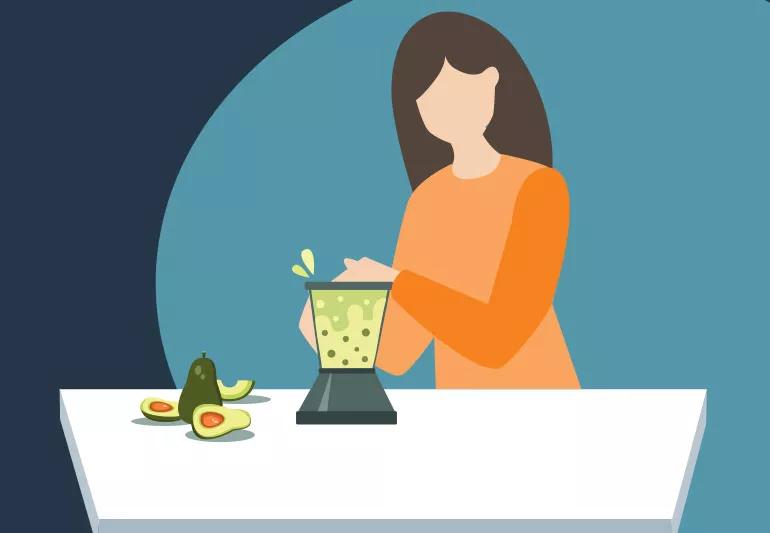An expert outlines everything you need to know

Maintaining a balanced diet that delivers necessary vitamins and nutrients to your body is a good rule of thumb for everyone. But it’s a particularly important aspect of life for those with Huntington’s disease.
Advertisement
Cleveland Clinic is a non-profit academic medical center. Advertising on our site helps support our mission. We do not endorse non-Cleveland Clinic products or services. Policy
Huntington’s disease is a genetic disease in which mutated genes create an unusually long protein that attacks and kills brain cells. This leads to uncontrollable movements in your hands, feet and face that worsen over time, affecting walking, talking and even the ability to swallow.
The symptoms of Huntington’s disease create a ripple effect that impacts all aspects of a person’s life, including nutrition. To better understand those diet and nutritional needs, we spoke with registered dietitian Nicole Hopsecger, RD.
The main way Huntington’s disease affects nutrition, says Hopsecger, is through Huntington’s typical symptoms. “These symptoms can affect a person’s ability to eat, potentially leading to malnutrition and weight loss,” she says.
The symptoms include:
Advertisement
Chorea and dysphagia can both increase choking hazards for those with Huntington’s, too, whether causing a person to swallow too soon or inducing a spasm in the diaphragm (chest), which could lead to aspiration (when food or drink ends up in the lungs instead of the stomach). That, in turn, can lead to aspiration pneumonia.
Certain changes or approaches to nutrition for someone with Huntington’s disease depend on which stage of the disease they’re in.
“In the early stage, it’s important for them to have a well-rounded diet to maintain that weight stability,” Hopsecger says.
The Mediterranean-DASH Intervention for Neurodegenerative Delay (MIND) diet has been associated with slower cognitive decline in studies of the general population, which might be worth a look. But, Hopsecger notes that there’s little research on the diet and its effects on those with Huntington’s disease, so it’s unknown if it has similar effects in this context.
At this point of Huntington’s disease, a person is likely beginning to experience increased difficulty with swallowing, though that issue will vary from person to person. While maintaining a well-balanced diet is important, adapting food choices can also make a big difference for people with Huntington’s disease.
“Changing the consistency of the diet may help in light of that dysphagia,” recommends Hopsecger. “Liquids can be thickened. Foods can be moistened, cut into small pieces or even pureed to make swallowing easier and safer for the patient.”
Again, the severity of a person’s condition will vary on a case-by-case basis, but those in the later stage of Huntington’s disease may need advanced assistance with getting nutrition. Whether that’s getting help from someone during feeding or, in more drastic circumstances, having a feeding tube — making sure those important nutrients and vitamins are included in meals is essential.
People with Huntington’s disease will need to make different nutritional choices because of conditions associated with the disease. Talking with a primary healthcare provider and a registered dietitian are the best ways to figure out a personalized diet that’ll work best for a person with Huntington’s.
A well-balanced diet is essential for overall health, but a person with Huntington’s disease may have additional caloric needs. “Someone with Huntington’s disease may require more calories than an average person because of chorea and other potential metabolic factors,” Hopsecger explains.
Advertisement
Healthy fats are a good source for these calories, says Hopsecger. They can help increase the number of calories consumed to help balance eating smaller amounts of food. Examples include:
Those with Huntington’s are at risk of losing weight due to using extra energy and being less likely to be able to do physical activities. Unintentional weight loss (losing weight without trying) can result in loss of muscle mass. While losing muscle in this scenario is not altogether avoidable, a diet rich in protein will help ensure there isn’t muscle loss because of nutritional deficits.
“Foods that meet those energy and protein needs are really important for those with Huntington’s disease,” says Hopsecger. “The brain gets fed first. If the diet does not supply enough energy for the brain and the rest of the body, fat tissue is broken down for energy. Once fat stores are used up, the body will break down muscle tissue for energy. It is because of this metabolic process that meeting both energy and protein needs are important.”
Examples of protein-rich foods include:
Advertisement
Again, because of difficulties with swallowing, soft, moist foods like canned fruit, smoothies, yogurt, oatmeal, and casseroles are good ways to package all of these fundamental nutrients, especially with fruits and vegetables.
With Huntington’s disease, there’s concern about the consistency of the food (like thick, chunky, rough or dry foods). “Those with Huntington’s disease should avoid foods that put them at risk of aspiration (sucking food into their airway) or exacerbating (making worse) other swallowing difficulties,” says Hopsecger.
These foods include:
For someone with Huntington’s disease, food and nutrition might need to be individualized, and meeting with a speech-language pathologist and registered dietitian is the best way to make those changes.
Eating smaller, more frequent meals can be a key way to maintaining nutrition with Huntington’s disease. “This can help manage a poor appetite or fatigue that can settle in with longer meals and swallowing problems,” advises Hopsecger.
A nutritional supplement, like a protein shake, could also be an option to add to meals or to have in between meals, she suggests. Just be sure to consult your healthcare provider and a registered dietitian for more information about what might work best.
Advertisement
Hopsecger cautions to avoid filling up on fluids, though, drinking in between meals.
Finally, consider using higher-calorie items with meals and snacks. For instance, using whole milk or cream with cereal or melting margarine or cheese on cooked vegetables. It not only keeps foods soft, but also delivers the balance of calories alongside nutrients that those with Huntington’s disease need.
People with Huntington’s disease may consider using different dishes and kitchen tools to meet their particular needs.
Huntington’s disease can prevent many challenges to maintaining proper nutrition. But using these tools, as well as following the suggestions for healthy foods balanced with extra calories can improve the quality of life for those with Huntington’s disease.
Learn more about our editorial process.
Advertisement

Aerobic exercise paired with resistance training is good, but an individualized plan is best

Here’s what to know about employment when living with this condition

Share your diagnosis with an inner circle of family and friends you can rely on

Ways to take care of your mental and physical health

The neurological disease can make it hard for individuals to take care of themselves

Properly prepared, elderberries can be a safe and healthy part of a balanced diet — just steer clear of supplements

Foods high in potassium, calcium and vitamins C and E can help lower your blood pressure

Your diet in the weeks, days and hours ahead of your race can power you to the finish line

You can improve your athletic performance over time by breaking up your workout regimen into focused cycles

The little blue pill might help with physical arousal, but there are better treatments for low libido in women

Sleep issues and certain foods can lead to an early morning headache